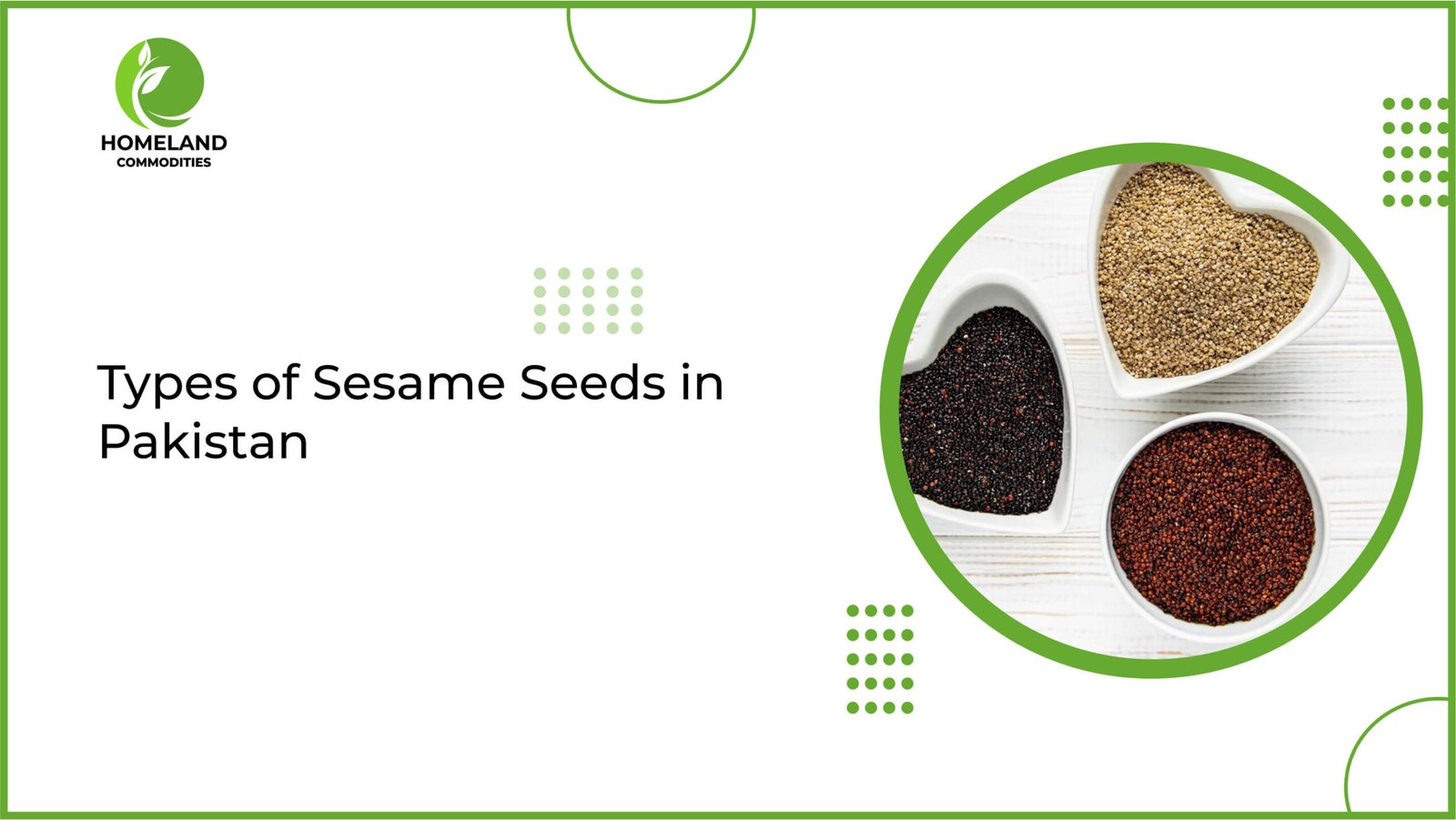Introduction
Sesame seeds, scientifically known as Sesamum indicum, have a long-standing history as an oilseed crop prized for their flavorful profile, high oil content, and nutritional value. In Pakistan, sesame seeds hold considerable importance in both agricultural practices and culinary traditions, boasting diverse varieties cultivated throughout the nation. This article offers a comprehensive examination of the types of sesame seeds cultivated in Pakistan, detailing their distinctive attributes, applications, and economic significance.
Major Types of Sesame Seeds in Pakistan
In Pakistan, sesame seeds are primarily categorized by their color into two main types: white sesame seeds and black sesame seeds. Each type possesses unique characteristics and finds various applications.But here we will also discuss brown and red sesame seeds.
1. White Sesame Seeds
Characteristics: White sesame seeds, the predominant variety in Pakistan, are small, oval-shaped seeds with a creamy white color. They are prized for their mild, slightly sweet, and nutty flavor.
Uses: White sesame seeds are versatile in culinary applications, used extensively in baking, cooking, and as a garnish in dishes like salads and sushi. They are also a key source of sesame oil, valued for its high smoke point and mild flavor, and utilized in traditional medicine and cosmetics for its moisturizing properties.
Cultivation Areas: White sesame seeds thrive in the fertile soils and favorable climates of Sindh, Punjab, and Khyber Pakhtunkhwa provinces.
2. Black Sesame Seeds
Characteristics: Black sesame seeds, less common but highly esteemed, are smaller and darker with a robust, earthy flavor and higher nutritional content compared to white sesame seeds.
Uses: Black sesame seeds are popular in traditional medicine and health foods, and are utilized in various culinary dishes, particularly in Asian cuisine for desserts and savory dishes. Black sesame oil is prized for its rich flavor and potential health benefits.
Cultivation Areas: Black sesame seeds are cultivated in specific regions of Sindh and Balochistan that provide optimal soil and climate conditions.
3. Brown Sesame Seeds
Characteristics: Brown sesame seeds exhibit a color and flavor profile between white and black varieties, offering a slightly nuttier taste and medium size.
Uses: These seeds are utilized similarly to white sesame seeds in cooking and for extracting sesame oil, finding applications in traditional recipes and snacks.
Cultivation Areas: Brown sesame seeds are grown in regions similar to white and black sesame varieties, albeit less commonly on a commercial scale.
4. Red Sesame Seeds
Characteristics: Red sesame seeds are less prevalent and feature a reddish color, similar in size and shape to white sesame seeds but with a distinctive, robust flavor.
Uses: Typically used in specialty dishes and valued for their medicinal properties in traditional practices.
Cultivation Areas: Cultivated in limited areas within Pakistan where specific soil and climate conditions favor their growth.
Economic Importance
Sesame seeds are a valuable cash crop in Pakistan, contributing significantly to the agricultural economy. The country exports substantial quantities of sesame seeds, particularly white and black varieties, to global markets such as China, Japan, and various Middle Eastern countries. The increasing global demand for sesame seeds and sesame oil presents lucrative opportunities for Pakistani farmers and exporters.
Local Consumption: Sesame seeds are a staple in Pakistani cuisine, used widely in traditional dishes, sweets, and snacks. Sesame oil extracted from these seeds is also extensively used in cooking and traditional medicine.
Export Market: Pakistan’s sesame seed exports serve as a major source of foreign exchange earnings. The country’s reputation for producing high-quality sesame seeds meeting international standards enhances its position in the global market.
Challenges and Opportunities
Challenges:
- Climate Change: Fluctuations in weather patterns pose risks to sesame crop yields, affecting farmer incomes and supply chains.
- Pest and Disease Management: Sesame crops are susceptible to pests and diseases that can impact both yield and quality.
- Market Fluctuations: Volatile global market prices for sesame seeds can affect profitability for farmers and exporters.
Opportunities:
- Improved Cultivation Practices: Adoption of modern agricultural techniques, high-yielding seed varieties, and sustainable farming practices can enhance productivity and quality.
- Value Addition: Investment in processing facilities for sesame oil, tahini, and other sesame-based products can expand market reach and profitability.
- Organic Farming: Growing demand for organic sesame seeds in international markets presents a niche opportunity, promoting organic farming practices can capitalize on this market segment.
Conclusion
Sesame seeds are a cornerstone of agriculture in Pakistan, with white and black varieties being the primary types cultivated. These seeds offer diverse culinary and medicinal uses and contribute significantly to the economy through local consumption and exports. Despite challenges such as climate change and market volatility, the sesame seed industry in Pakistan holds promising opportunities for growth through enhanced agricultural practices and expanded market presence. With strategic investments and sustainable farming methods, Pakistan is poised to remain a leading producer and exporter of premium sesame seeds globally.


